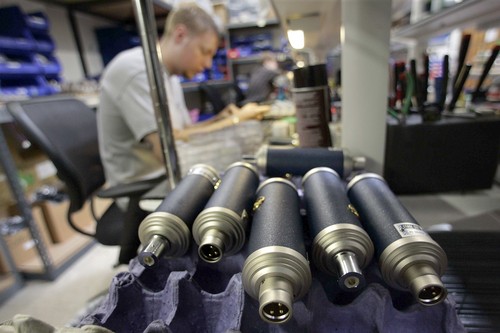 August 13, 2008
August 13, 2008
From the Los Angeles Times
BUSINESS NEWS
Blue Microphones turns up the volume Los Angeles Times Staff Writer
Making audio tools for mainstream laptop users is instrumental to its success. Apple nudged it to develop the Snowball USB mic, which became a hit with users of recording software such as GarageBand.

Microphone bodies point at assembly engineer Jordan Butcher as he works on a hand-built
piece. Blue Microphones still makes the studio mics that built its reputation.
By Nathan Olivarez-Giles
July, 21, 2008
Blue Microphones got its start building high-end studio microphones for the recording industry, making a name for itself as a niche player. But niche no more. With a nudge from Apple Inc., the Westlake Village company built a low-cost microphone for use with music recording software. That mic, called the Snowball, has become a hit with aspiring pro musicians and dedicated hobbyists who make demo recordings on their laptops instead of shelling out $50 an hour or more for studio time. The company projects $10 million in sales this year, double what it did last year and up from $3 million in 2007. What’s more, its higher profile helped draw the attention of Los Angeles private equity firm Transom Capital Group, which bought Blue from founders Skipper Wise and Martins Saulespurens for an undisclosed amount in April 2008. Transom is betting that Blue will expand its market beyond the musicians who have taken it this far. Its products can be used to record podcasts, soundtracks for videos and audio for videoconferences. It also offers an HD webcam.
“Blue is in the position to take recording from this rarefied thing only recording artists know about to something that can integrate into your life just as much as your digital camera does,” said Russ Roenick, a managing director at Transom. “A child can use our mics or an 18-year-old can upload their video and audio on Facebook.”
That vision is dramatically different from what the company founders had in mind when they started Blue Microphones in 1995.
Then, Wise was a jazz musician recording and producing for companies including Cypress Records. He had met Saulespurens during recording sessions in Europe in the mid-1980s, when Saulespurens was an audio engineer at the Latvian Conservatory of Music.
Saulespurens found his way to the States, and the two men started Blue on a shoestring budget a few years later, at first repairing vintage microphones from the 1950s and ’60s and then advancing to building their own mics.
The name “Blue” is a tip of the hat to Saulespurens’ homeland: It’s an acronym for Baltic Latvian Universal Electronics.
“I just wanted Latvia in the name somewhere,” Saulespurens said.
“Skipper said the name just had to be easy to remember, so he said, ‘Blue, let’s just call it Blue.’ ”
The company’s high-quality mics were well regarded within the recording industry, enough so that when Apple was getting ready to launch its GarageBand recording software, a programmer sent Wise an early copy.
“They were concerned about the sounds that would be going into GarageBand,” Wise said. “If you use a bad microphone to record anything, you get bad sound — garbage in, garbage out.”.
After testing some USB microphones on the market, Wise said, he knew Blue could do better.
“At that time, nobody on the professional recording side of music was thinking about consumer electronics, and nobody on the consumer side was thinking about music,” he said.
“But after using the software, I knew this was going to change everything. GarageBand changed the type of business Blue is.”
Wise said Apple’s global supply manager, Pete Lacey, encouraged them to put the computer mic into production, and the Snowball was born. Lacey and his colleagues at Apple also pushed to stock the mics in Apple’s stores, Wise said.
“Apple stores provide exposure to an affluent buyer, a discriminate buyer, someone who is more likely than the average PC user to be interested in digital media and creating media,” said Ross Rubin, a consumer electronics analyst with NPD Group.
“Apple has supported Blue, and Blue has supported the Mac and the iPod, and they’re reaping the rewards of coming to market early with their consumer microphones.”
Since the Snowball hit shelves in 2005, Blue says, it has sold 300,000 of the $99 white, softball-size USB mics. Blue also makes other mics, and in addition to its website and the Apple Store, its products can be found at Best Buy, Fry’s Electronics, Guitar Center and other stores. One of its newest products is the Mikey, which plugs into iPods and iPhones, records in stereo and sells for $79.
As the company grew, Wise and Saulespurens found they needed help running the business. An attorney friend introduced them to Roenick and others at Transom, which took a majority stake last year. Transom took over Blue’s day-to-day operations, doubled its employees to about 50, and has invested in new product development with an eye toward expanding the company’s consumer range, Wise said.
Wise, as president, and Saulespurens, as chief engineer, run the creative side of the company, develop new products and hold a minority share.
Blue remains committed to the hand-built studio mics that built the company’s reputation and sell for as much as $10,000, but the future of the microphone manufacturer lies with the mainstream, Wise said.
“There are more than 9 million artists on MySpace,” he said.
“The majority of them don’t record in a full studio but record at home. So what people need more than ever are good, affordable microphones.”
